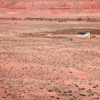Encyclopedia of the Southwest (B)

|
bedroll A bundle of blankets and bedding materials that have been rolled up and tied together so that they can be transported from place to place. A bedroll can be easily… |

|
bee A family of insects with over 20,000 species that relies entirely on pollen and nectar from flowers as its food source. As bees transport themselves from flower to… |

|
Belacani More often spelled bilagáana, this word is an Anglicization of the Navajo word used to refer to people who have white skin. |

|
Beloved Ones Hillerman alternates the definition of "Beloved Ones" and sometimes it is a way of referring to ancestors and sometimes to the gods of the Zuni creation story. In Zuni… |

|
Bernalillo County Medical Center, New Mexico A large medical facility located next to the University of New Mexico (UNM) campus in Albuquerque, New Mexico. First known as the Bernalillo County Indian Hospital, the… |

|
bicycle Often commonly referred to as a "bike," the bicycle is a two-wheeled, man-powered mode of transportation that became popular as both entertainment and exercise in the… |

|
bifocal glasses Prescription glasses in which the lenses are horizontally divided into two parts, each with a different refractive strength. Usually the upper part is for distant or… |

|
Big Dipper A group of five stars that create the major constellation also known as Ursa Major. These stars appear to rotate around the North Star, also known as Polaris. For the… |

|
Big Fly In some versions of Navajo ceremonial traditions, Big Fly, known as Do'tsoh in Navajo, and what Hillerman sometimes refers to as Sacred Fly, or Little Winds, is the… |

|
Big Mountain, Arizona The most noticeable geologic formation in Black Mesa, Arizona. This mountain, called Dził Ntsaaí in the Navajo language, translates to "Extensive Mountain" in English.… |

|
Big Reservation, Arizona, New Mexico & Utah The term Big Reservation refers to the Navajo Reservation or the Navajo Nation as it has been called since 1969. The Navajo Nation covers 27,425 square miles of… |

|
Big Snake One of the spirit guardian creatures of the Navajo people, Big Snake is a mythological creature associated with sacred sand paintings as well as healing ceremonies.… |

|
big-game hunter Big-game hunting is the hunting of large wild animals such as bear, lions, leopards, elk, moose, or bison. Big-game hunters often display the heads of their hunted… |

|
billfold Similar to a capacious envelope, a billfold, sometimes referred to as a wallet, is usually made of leather or other pliable yet durable material and is designed to… |

|
Binding The manner in which a book is put and held together, especially in the area of its spine. |

|
binoculars A handheld optical instrument with magnifying abilities, composed of two telescopes and a focusing device. Binoculars are used to observe objects at a distance for… |

|
Bisti, New Mexico An area within the Navajo Nation reservation in northwestern New Mexico, about 30 miles south of Farmington. The Navajo name Bisti (or Bistahi) refers to the eroded… |

|
bitch This term refers to female members of the family Canidae, including wolves, foxes, jackals, coyotes and domesticated dogs. This term first appeared in the 11th century… |

|
bitter Bitter, as an adjective, can mean sour, acidic, or biting. Bitter can also refer to emotions or attitude, suggesting that when one is bitter, one is filled with… |

|
Bitter Water clan According Navajo traditional lore, the Bitter Water (Todích'íí'nii) clan was one of the original groups formed by Changing Woman who, as the legend goes, created four… |

|
Biz-E-Ahi Wash, Arizona Also written as Bis'ii ah Wash, Biz-E-Ahi Wash is a tributary of the Nazlini wash in Apache County, Arizona. In Navajo, Bis'ii ah means “standing adobe formation." Biz… |

|
Black Dancers A group of dancers who are covered in mud and perform in the Enemyway ceremonial. This portion of the ceremony is only performed at a request of the patient and is not… |

|
Black God Black God (Haashchʼééshzhiní), sometimes referred to as Darkness to Be One by Tony Hillerman, is the god of fire and creator of the stars in Navajo mythology. Not all… |

|
Black Mesa, Arizona Black Mesa is an elevated, bowl-shaped region (approximately 4,000 square miles) located in northern Arizona. It is part of the Navajo Reservation; a portion of the… |

|
Black Rain Chant The Black Rain Chant is likely a fictional reference to a Navajo ceremonial. This chant might refer to one performed as a recreation of the story about Coyote stealing… |
